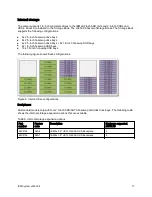
IBM System x3950 X6
2
Key features
The increasing demand for cloud-computing and analytics workloads by enterprises to meet social,
mobile, and Big Data requirements drives innovation to find new ways to build informational systems.
Clients are looking for cost-optimized fit-for-purpose IT solutions that manage large amounts of data,
easily scale performance, and provide enterprise class reliability.
Built on decades of innovation, IBM introduces its sixth generation of Enterprise X-Architecture
technology, IBM X6 servers. IBM X6 servers are fast, agile, and resilient:
Fast
application performance means immediate access to actionable information.
Agile
system design helps to reduce acquisition costs and provide the ability to upgrade processor
and memory technology at each refresh within the same chassis.
Resilient
platforms maximize application uptime and promote easy integration in virtual
environments.
IBM X6 servers continue to lead the way as the shift toward mission-critical scalable databases, business
analytics, virtualization, enterprise applications, and cloud-computing applications accelerates.
Fast application performance
The server offer numerous features to boost performance:
With eXFlash memory-channel storage, the server delivers up to 12.8 TB of ultra-low latency flash
memory by using IBM WriteNow technology, which is ideal for high-performance applications.
Supports four, six, or eight E7-8800 v2 processors with 120 cores and 240 threads to maximize the
concurrent running of multi-threaded applications.
Supports memory speeds up to 1600 MHz.
Supports up to 12 TB of memory in 192 DIMM sockets, with 24 DIMMs per processor.
Supports IBM memory-channel storage and IBM eXFlash DIMMs, where solid-state storage devices
are installed in memory DIMM sockets. These devices are directly connected to the processors and
provide the lowest latency values in the industry.
Intelligent and adaptive system performance with Intel Turbo Boost Technology 2.0 allows processor
cores to run at maximum speeds during peak workloads by temporarily going beyond processor
thermal design power (TDP).
Intel Hyper-Threading Technology boosts performance for multi-threaded applications by enabling
simultaneous multi-threading within each processor core, up to two threads per core.
Intel Virtualization Technology integrates hardware-level virtualization hooks that allow operating
system vendors to better use the hardware for virtualization workloads.
Intel Advanced Vector Extensions (AVX) improve floating-point performance for compute-intensive
technical and scientific applications.
Supports a 12 Gbps SAS RAID portfolio.
The usage of solid-state drives (SSDs) instead of, or along with, traditional spinning drives (HDDs)
can improve I/O performance. An SSD can support up to 100 times more I/O operations per second
(IOPS) than a typical HDD.
PCI Express 3.0 I/O adapter slots that improve the theoretical maximum bandwidth by almost 100%
(8 GTps per link using 128b/130b encoding) compared to the previous generation of PCI Express 2.0
(5 GTps per link using 8b/10b encoding).

















